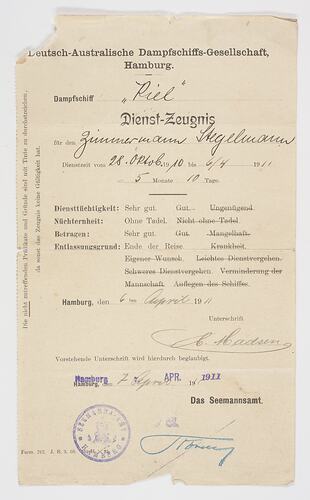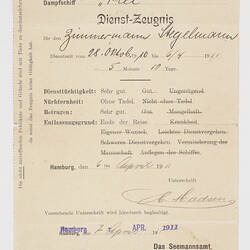Summary
Service report issued to J. Stegelman by the German Australian Steamship Company Hamburg. It states that he worked as a carpenter on the steamship 'Riel' for five months and ten days from 28 October 1910 to 6 April 1911. It lists his reason for leaving as the end of journey and notes that his work ability, sobriety and behaviour were very good.
Description of Content
Service report issued by the German Australian Steamship Company Hamburg for J Stegelmann who worked as a carpenter on the steamship 'Riel' for 5 months 10 days from 28/10/1910 to 6/4/1911. Work ability, sobriety, behaviour very good. Reason for leaving - end of journey
Physical Description
Yellowing paper with black printed text. Personal details written in pen. Some purple stamps. All in German. Small tear on top left hand corner.
Significance
Johannes Stegelman's story is a great example of more unorthodox migration. Jumping ship was a common way to start a new life in Australia, especially for sailors on merchant ships, and dates back to the 1850s gold rush with sailors jumping ship to head for the goldfields (John Simpson Kirkpatrick of 'Simpson and his donkey' fame arrived in Australia by jumping ship). Stegelman's objects all relate to his career in both the German Navy and the merchant navy including the hire document that brought him to Australia. The story is also interesting for its cross-cultural marriage and the bringing together of two very different migrant stories from different periods in time.
Gladys Leichti's objects and story represents the push to attract young British girls for domestic service in the 1920s and the role of philanthropic organizations such as the Salvation Army in meeting this demand.
More Information
-
Collecting Areas
Migration & Cultural Diversity, Public Life & Institutions, Transport
-
Acquisition Information
Donation from Margaret Steglman, 29 Nov 2006
-
Issued To
-
Other Association (See Comments)
German Australian Steamship Co, 28 Oct 1910 - 6 Apr 1911
Period employed by the German Australian Steamship Co on the SS Riel. -
Inscriptions
Text: Deutsch-Australische Dampfschiffs-Gesellschaft,/Hamburg.
-
Classification
-
Category
-
Discipline
-
Type of item
-
Overall Dimensions
22.3 cm (Length), 13.3 cm (Width)
-
Keywords
Apprenticeships, German Communities, German Immigration, Immigration, Merchant Seamen, Shipboard Travel, Shipping Companies, Shipping Industry, Trades, Tradespeople



